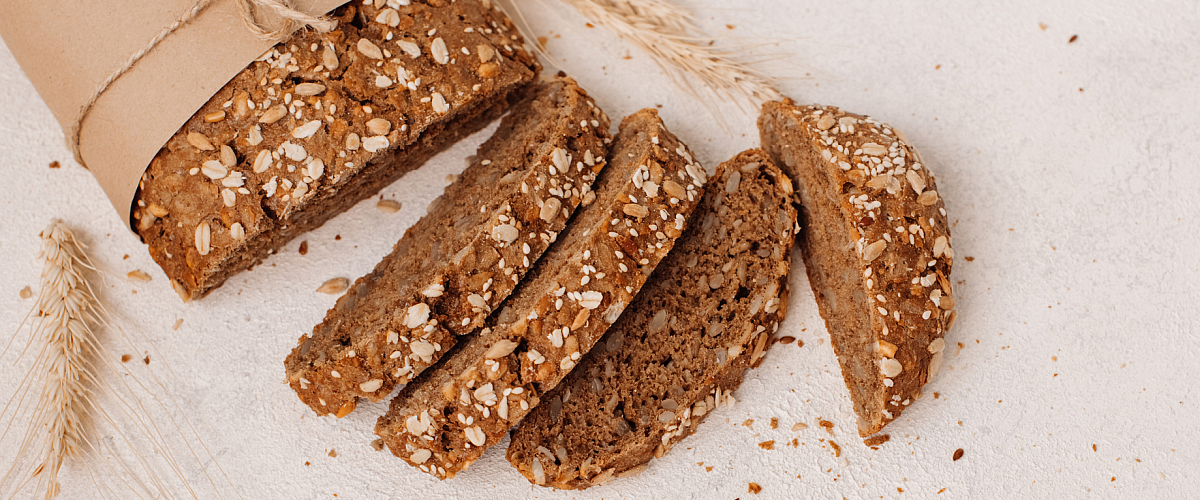The smell of chocolate chip cookies right out of the oven. The airy crumb of fresh bread. The care that goes into icing a birthday cake. There’s a lot to love about home baking!
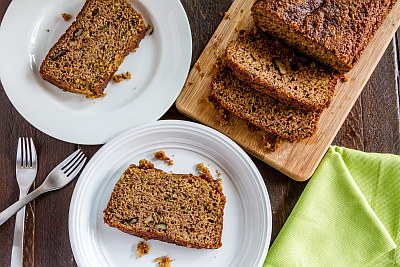
At the same time, baked goods have a reputation for … well, not exactly loving us back. But breads, cakes, and cookies don’t have to be full of empty calories. The road to healthier baking is paved with clever ingredient swaps—and one of our all-time favorites is using whole grains.
If that gives you pause, have no fear. We sought out Ben Guggenmos, a chef and culinary manager with our partner Rich’s, a family-owned food company, for his expertise on the subject. Here he helps answer common questions about baking with whole grains.
What’s the big deal with whole grains?
You often hear that half the grains in your diet should be whole grains. That’s because whole grains are nutrition powerhouses. Their fiber, protein, healthy fats, and other nutrients can help reduce your risk for heart disease, stroke, type 2 diabetes, and inflammation, as well as certain cancers. Whole grains have also been shown to help you regulate blood sugar and maintain a healthy weight.
“These health benefits come from the whole grain’s bran and germ,” Ben explains. “Processing the grain strips out all that good stuff. That’s why you want to substitute whole grains for refined grains whenever possible.”
How will whole-grain flour affect my recipes?
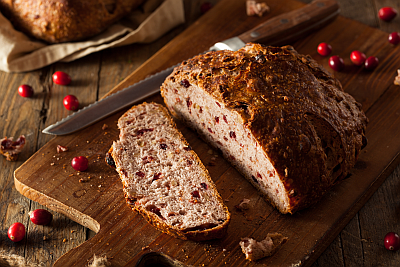
Whole grains can play a role in nearly any meal, but with baking we’re mostly talking about flour. Whole-grain flours are denser than refined, and that does impact the baking process.
“Whole-wheat doughs typically take longer to proof and cook,” Ben shares. “But with a few tricks, you can adapt your baking methods.” Here are his go-to discoveries:
- Meet halfway: Substitute only 50% whole-grain flour instead of the entire amount called for in the recipe. “This way, you usually don’t have to worry about making any other changes,” says Ben. Using the 50/50 technique, our Zucchini Bread recipe below is the perfect first-step into whole-grain baking.
- Add a splash: In yeast or cookie recipes, Ben likes to add a bit of water—2 teaspoons for every cup of whole-wheat flour. The whole-grain dough will soak up that extra liquid. 1 ½ cup of water goes a long way in our Cranberry Walnut Bread recipe.
- Give it a rest: If you do go all-in with whole-wheat flour, let the dough rest overnight before baking. This step will break down the grains, making them easier to digest in the finished product. “You’ll also be able to absorb the nutrients in the bread more easily,” Ben adds.
- Don’t overwork it: Each time you knead whole-wheat dough, the sharp bran cuts into the strands of gluten. Knead too much and you’ll end up with a tough loaf that doesn’t rise. “Use a light touch, kneading it as little as possible,” Ben advises. Adding vital wheat gluten can counteract this phenomenon, helping you achieve that coveted, fluffy bread texture. And if you want to avoid kneading all together, explore a no-knead bread recipe.
- Look for proof: Proofing is the crucial step where yeast does its thing—that is, producing carbon dioxide gas to make dough rise. But how can you tell when proofing is complete? Give your loaf a poke! “If the dough bounces back quickly, it’s not done yet. If your fingerprint stays, that means it’s ready to bake,” says Ben.
- Take the temp: We’re big fans of instant-read thermometers to tell us when meat and other dishes are cooked to a safe temperature. Turns out you can do that with bread, too! “For breads with milk, egg, or butter, look for a reading of 200 degrees Fahrenheit. All other breads are safe at 190,” Ben tells us.
You hear a lot about whole wheat flour. What other whole-grain flours are out there?
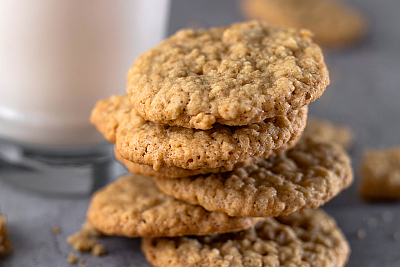
Once you’re hooked on whole grains, you’ll want to expand your horizons. Ben points to trendy ancient grains—so named because they can be traced directly back to their roots.
“Buckwheat, millet, and quinoa come from seeds and work well in baking,” he advises. “They are all gluten-free and great sources of protein—in fact, buckwheat and quinoa are complete proteins.”
There’s also oat flour. Too delicate to bake with alone, it can be mixed with wheat flour. “I love incorporating oat flour into breads because it adds a sweet, smooth texture I enjoy. You can make it at home from old-fashioned oats and a food processor!”
What if I’m still getting used to the taste of whole grains?
Ben’s got your back here, too, with some surprising ways to enhance the flavor and texture of your whole-grain breads.
- Orange juice: Replace 1/8 of the recipe’s wet ingredients with OJ to tone down the whole-grain flavor.
- Potato flakes: They are not just for instant mashed potatoes! Add ¼ cup per loaf for a softer texture.
- Honey: Adding 2 to 4 tablespoons imparts a welcome hint of sweetness.
- Milk: Can replace ¼ to ½ of the wet ingredients for a softer loaf.
- Vegetable Oil: Adding 2 to 4 tablespoons lends fat and moisture to a bread recipe.
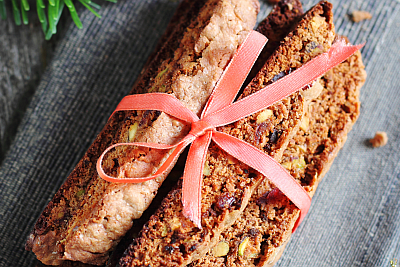
Yet another option is hiding in plain sight: White whole-wheat flour. (And no, that’s not an oxymoron!) This product is made from a different variety of wheat and can be freely substituted for all-purpose flour.
“White whole-wheat flour is lighter in color, has a less intense flavor, and comes with the same health benefits of regular whole-wheat flour,” Ben explains. “It also tends to appeal to kids, who often resist eating darker colored breads.”
OK, I need more whole grains in my (baking) life. Where should I begin?
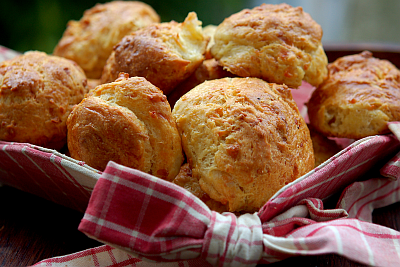
Bread might not be your best first project. Novice bakers may want to try whole-grain cookies, muffins, or quick breads. “These baked goods are a good place to start because they are dense and moist. You can use whole-grain flour and hardly tell the difference,” Ben says.
If it’s bread you’re after (understandably so!), have fun with it. Whether you make your own or use store-bought dough, try shaping it into loaves, baguettes, rolls, pizza crusts, and more. “It’s a great way to get children engaged in the kitchen,” Ben suggests. “I bake with mine a lot. We have fun testing new recipes together.”
Let’s get baking!
Morning, noon, or night—whole-grain baked goods really hit the spot. Here, Rich’s provides several recipes to try at home, whenever a craving strikes!
| Meal | Whole-Grain Ingredient | Recipe Recommendation |
| Breakfast | Whole-wheat flour | Zucchini Bread Cranberry Walnut Bread |
| Sides & Snacks | Whole-grain pizza or bread dough (store-bought or homemade) | Soft Pretzel Twists Sundried Tomato Asiago Dinner Knots |
| Dessert | White or regular whole-wheat flour | Chewy Whole Wheat Oatmeal Cookies Whole Wheat Cranberry Pistachio Biscotti |
Calling all home bakers! Show off your creations featuring whole-grain flour. Tag us on Instagram @aramark.
Note: Since everyone’s health history and nutritional needs are so different, please make sure that you talk with your doctor and a registered dietitian to get advice about the diet and exercise plan that‘s right for you.

